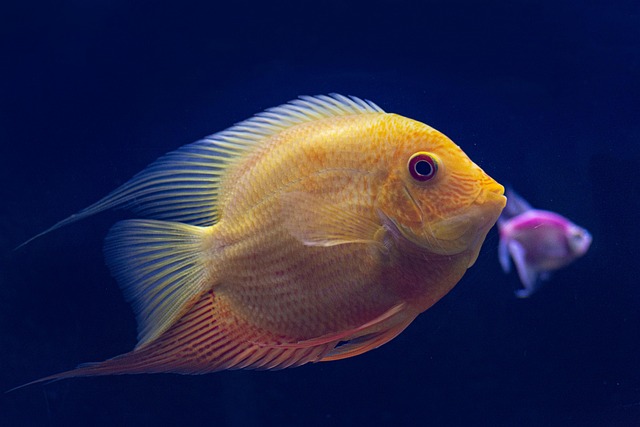Aquascaping transforms homes into underwater ecosystems by blending art and science, creating aesthetically pleasing landscapes within aquariums through hardscaping for aquariums. Hardscaping involves strategically placing rocks, wood, and man-made structures to establish balance, enhance visual appeal, and optimize function. These elements provide structural support for plants, create depth, offer hiding spots for fish, and enable the reproduction of diverse ecosystems. By integrating these components, skilled aquascapers can craft unique terrains that balance artistry with aquarium maintenance, making it a captivating hobby while ensuring aquatic species' well-being.
“Discover the art of aquascaping, where aesthetics meet functionality. This practice transforms aquatic spaces into visually stunning and harmonious environments. In this comprehensive guide, we explore the creative fusion of understanding aquascaping and hardscaping—a dynamic duo that redefines aquarium design.
From the role of aesthetics in shaping your underwater oasis to incorporating practical hardscaping elements, learn how to balance beauty and purpose. Achieve a seamless blend, creating stunning aquatic environments that captivate and inspire.”
Understanding Aquascaping and Hardscaping: A Creative Fusion
Aquascaping is an art form that brings the beauty of nature into our homes, focusing on creating aesthetically pleasing underwater landscapes within aquariums. But it’s more than just arranging plants and decor; it involves a creative fusion with hardscaping—the design and construction of physical structures. Hardscaping for aquariums plays a crucial role in establishing balance, enhancing aesthetics, and optimizing function.
By integrating hardscaping elements like rocks, wood, or man-made structures, aquascapers can craft unique terrains that support both aquatic life and visual appeal. These hardscape materials offer structural support for plants, create depth and dimension, and provide hiding spots for fish. They also allow for the reproduction of diverse ecosystems, from rocky riverbeds to forest floors, ensuring a vibrant and healthy aquatic environment. This fusion of aesthetics and function is what makes aquascaping such a captivating hobby, blending artistry with the science of aquarium maintenance.
The Role of Aesthetics in Aquarium Design
In aquarium design, aesthetics play a pivotal role in creating visually stunning and harmonious aquatic environments. Beyond merely focusing on vibrant fish and lush plants, aquascapers must consider the overall visual appeal and how different elements interact to form a captivating tapestry. Hardscaping for aquariums involves strategically placing decorative structures, rocks, and wood to create depth, contrast, and natural-looking landscapes. These features not only enhance the beauty of the aquarium but also serve practical purposes like providing hiding spots for fish or stabilizing decorations.
The balance between aesthetics and function is a delicate art. Skilled aquascapers meticulously select materials that not only look visually pleasing but also complement the chosen aquatic theme and species. Incorporating hardscapes allows for creative expression, enabling designers to craft unique underwater landscapes that captivate viewers while meeting the physiological needs of the aquatic inhabitants.
Incorporating Functionality Through Hardscaping Elements
Incorporating functionality into your aquascaping design is just as important as achieving a visually stunning aesthetic. Hardscaping elements, which include structures like rocks, caves, and wood, serve a dual purpose in both enhancing the beauty of an aquarium and providing essential habitats for aquatic life. These features not only add depth and texture to the landscape but also create nooks and crannies where fish can hide, rest, and breed.
When incorporating hardscaping into your aquascaping project, it’s crucial to consider the size, shape, and placement of these elements relative to the tank’s dimensions and the behavior patterns of its inhabitants. For example, larger rocks provide hiding spots for shy species while smaller caves might be preferred by more active fish. Balancing these elements ensures a harmonious environment that supports both the well-being of your aquatic pets and the overall visual appeal of your aquarium.
Achieving Balance: Tips for Creating Stunning Aquatic Environments
Achieving balance between aesthetics and function is key when creating stunning aquatic environments through aquascaping. Start by considering the overall design and layout, ensuring that elements like rocks, plants, and decorations complement each other while providing necessary habitats for aquatic life. Incorporate hardscaping techniques—such as meticulously placed stones and wood—to create depth and visual interest, mirroring natural landscapes found in many freshwater and marine ecosystems.
Select plant species not only for their beauty but also for their environmental benefits. Some plants act as natural filters, absorbing excess nutrients and improving water quality. Equally important is ensuring that the chosen hardscape materials are suitable for aquariums; some stones or woods might release harmful chemicals when submerged, so thorough research and selection of aquarium-safe options are crucial to maintaining a healthy ecosystem.
Aquascaping is an art that seamlessly integrates aesthetics and functionality, enhancing both the visual appeal and practical aspects of aquatic environments. By combining creative aquascaping techniques with strategic hardscaping elements, it’s possible to create stunning, balanced ecosystems that cater to both the eye and the needs of aquatic life. Incorporating hardscaping for aquariums allows for a harmonious fusion of design and practicality, ensuring these spaces are not only beautiful but also thriving habitats.
